Final project

The goal of the grand finale project is to make 'something' (anything!), exploring and using different Fab skills.
Initial ideas
Initially, there were several ideas I wanted to explore, namely:
Bureau crazy (Van het kastje naar de muur): The main final project idea was to craft an interactive ‘kastje naar de muur’ (from pillar to post) award for empowering the public and fight against bureau-crazy occurrences. I chose to develop this project in most detail (see also Week 18 and beyond for more detailed progress).
The only way is up-cycling: The idea is to use dead stock and use digital fabrication techniques to create > upcycle old material into something new and more attractive. (see Week 15: Composites in which I briefly explored this idea).
Interactive physical models: Exploring the idea of using interactive scale models (e.g. technology-augmented miniatures and dollhouses) as a dynamic tool for co-design, creation and better public understanding of technology.
Picture perfect: Physical and interactive tangible means for supporting, remembering and cherishing positive moments and accomplishments (when e.g. caring for someone with dementia). See Week 5: 3D Scanning and printing, in which I explored Lithophanes as tangible reminders.
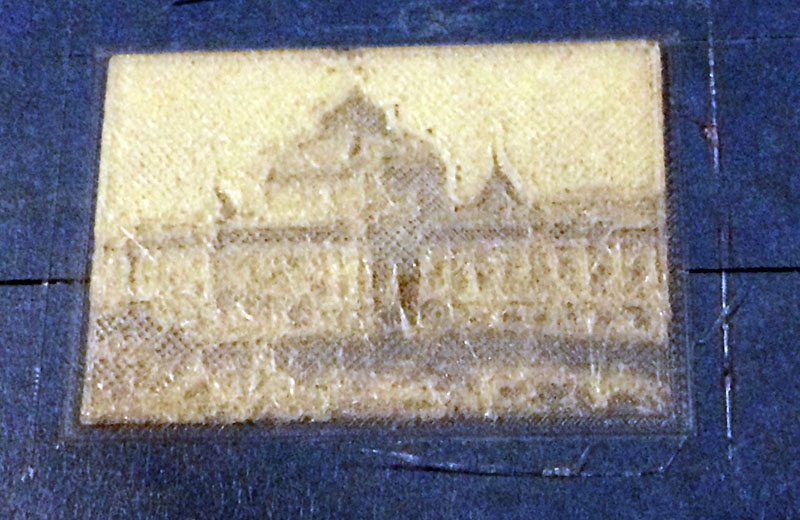 ‘Bureau crazy’: Going nowhere fast
‘Bureau crazy’: Going nowhere fast
The goal of this final project is to craft an interactive award/ installation for fighting against bureau-crazy occurrences by means of interactive physicalisation.
This idea originates from the Dutch saying ‘van het kastje naar de muur gestuurd worden’ (literally: going from cabinet to wall). What it means is going back and forward in a fruitless manner, going from pillar to post (nowhere fast) while occasioning much frustration in the process. Adding to the frustration is that such bureaucratic processes often lack tangible means to improve and visualize such situation and a clear party one can blame.
To address this, using and exploring (visual) digital fabrication techniques, the modular interactive design of Bureau crazy is meant to physicalize such frustrating processes, allowing the public to have a means to direct their frustration in a tangible way or at least demonstrate such situation.
What does it do?
The project entails a wall and a cabinet (miniature award and real life size), which reacts in an endless loop by pointing you (using LED charlieplexing and sound) to either the wall or the cabinet. When close to the cabinet, you hear, "ga naar de muur" (go to the wall). When close to the wall, you hear, "ga naar het kastje" (go to the cabinet).
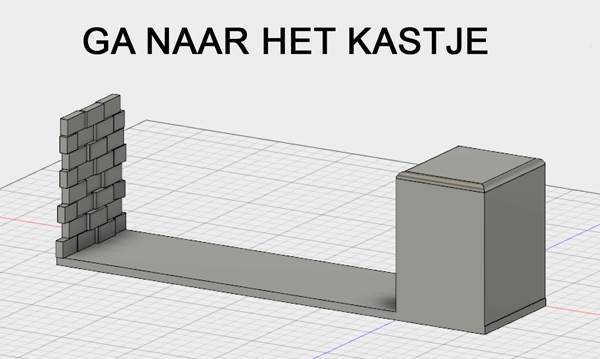 You could leave your bureau crazy stories on the (wailing) wall or in one of the drawers (though due to the bueaucratic nature these may already be full with "pillar to post" files). It is designed in a modular way, so that it can be used for big and small size; (1) as 'award'/verbal granade for parties guilty of bureaucracy, and (2) with its enclosure for electronic components it can also be integrated large-scale in a wall/ cabinet as museum or office-like installation.
You could leave your bureau crazy stories on the (wailing) wall or in one of the drawers (though due to the bueaucratic nature these may already be full with "pillar to post" files). It is designed in a modular way, so that it can be used for big and small size; (1) as 'award'/verbal granade for parties guilty of bureaucracy, and (2) with its enclosure for electronic components it can also be integrated large-scale in a wall/ cabinet as museum or office-like installation.
Materials and components
Technical components: The project uses HR ultrasonic distance sensor (for measuring the proximity to either the wall or the cabinet), a charlieplexed LED array (making continuous flashing movements from cabinet to wall), a Touch board (with micro sd card reader) and speaker for (mp3) sound output. It also uses a LiPo battery and jumpers/headers to communicate between boards and to act stand-alone.
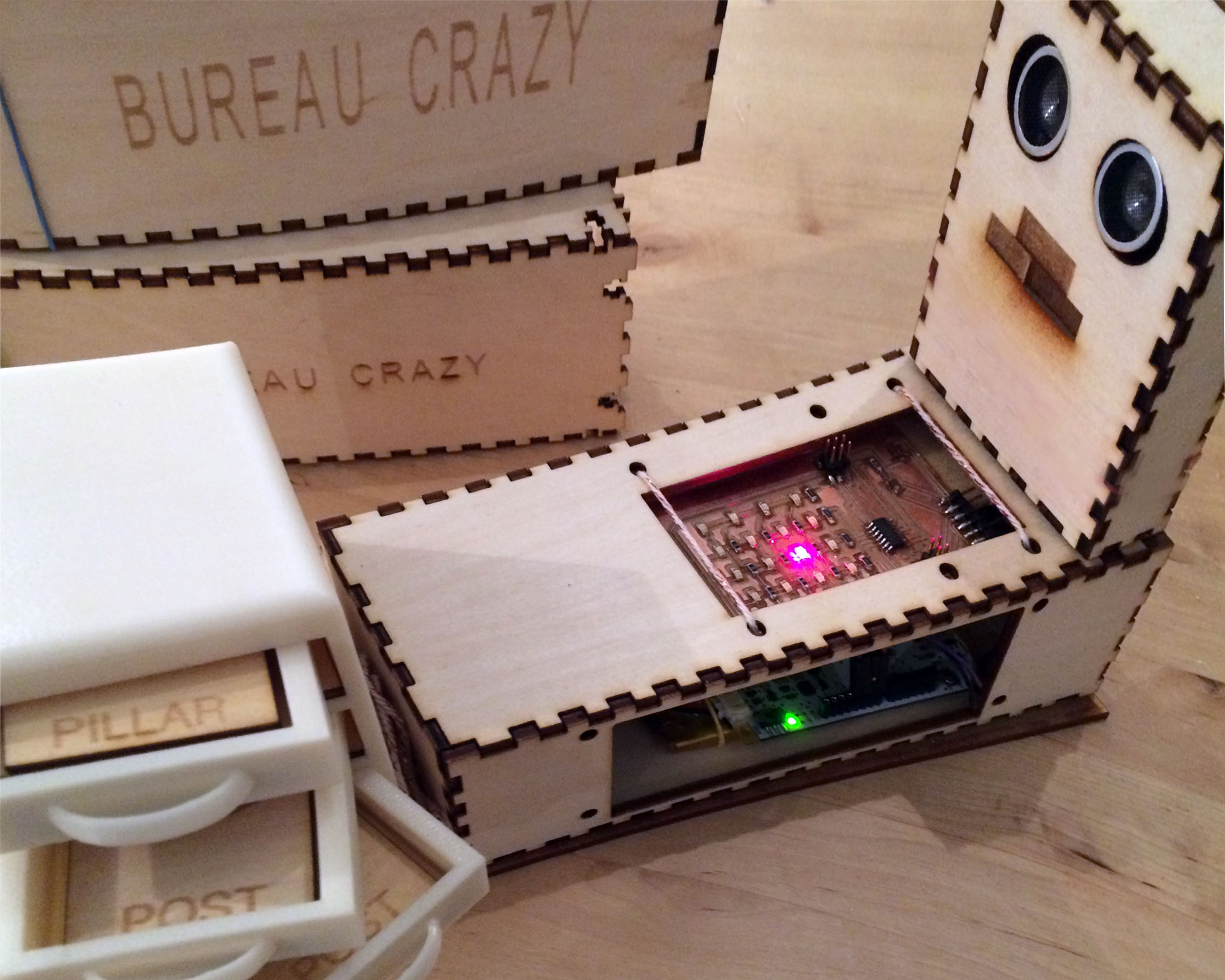 Physical components: A wall. A cabinet.
Physical components: A wall. A cabinet.
Real-life 'installation' version: The electronics come in a specially designed modular casing that can be placed (without small-scale cabinet) in a purposely-crafted real-size cabinet, in particular the one I made with the Shopbot. It can also just be incorporated into an existing cabinet (already in the organisation's space or in de Stedelijk museum) so to support sustainable practices.
Miniature 'award'/'verbal granade' version: 3D printed and 2.5 laser cut wall and cabinet. I designed a casing so to properly fit the electronics (distance sensor, LED board -sound (touch) board and speaker). These can stand on a (laser-cut) tray to fit and combine as award together. These can also be used as an empowering tool: left as a verbal granade at a party that is guilty of bureau crazy (with victim's telephone number so to force faster solution).
Processes and techniques used:
- Computer Controlled Machining (with Shopbot) for making the large-scale cabinet
- Laser cutting and engraving (for the casing of the distance sensor, electronic components and 'award' tray), ...

- Printing with Uprint 3D printer (for crafting kastje/cabinet and alternative distance sensor casing)
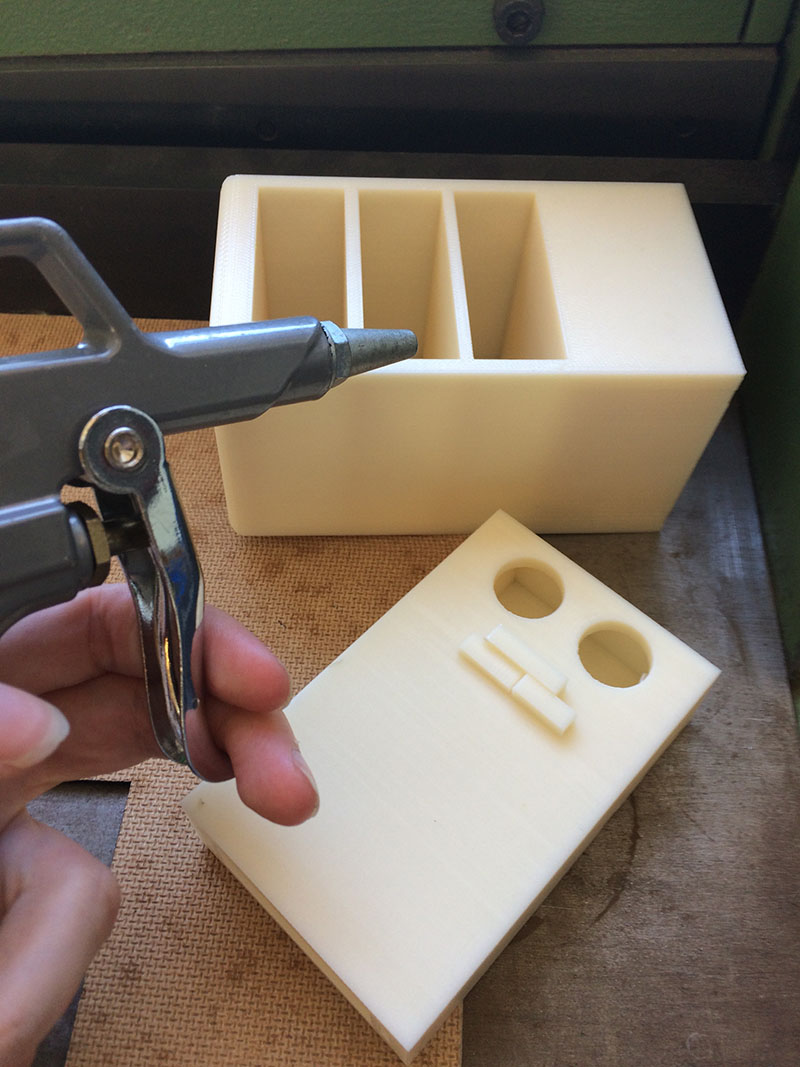
- Molding and casting (just to experiment with stone wall piece)

- Milling with the Modela for Charlieplexing LED board
- Reflow machine (for soldering the Charlieplexing LED board components)
- Charlieplexing for LED action (and so limiting the needed pins)
- Wireless communication and networking for stand-alone sound and LED animation output in accordance to sensed distance
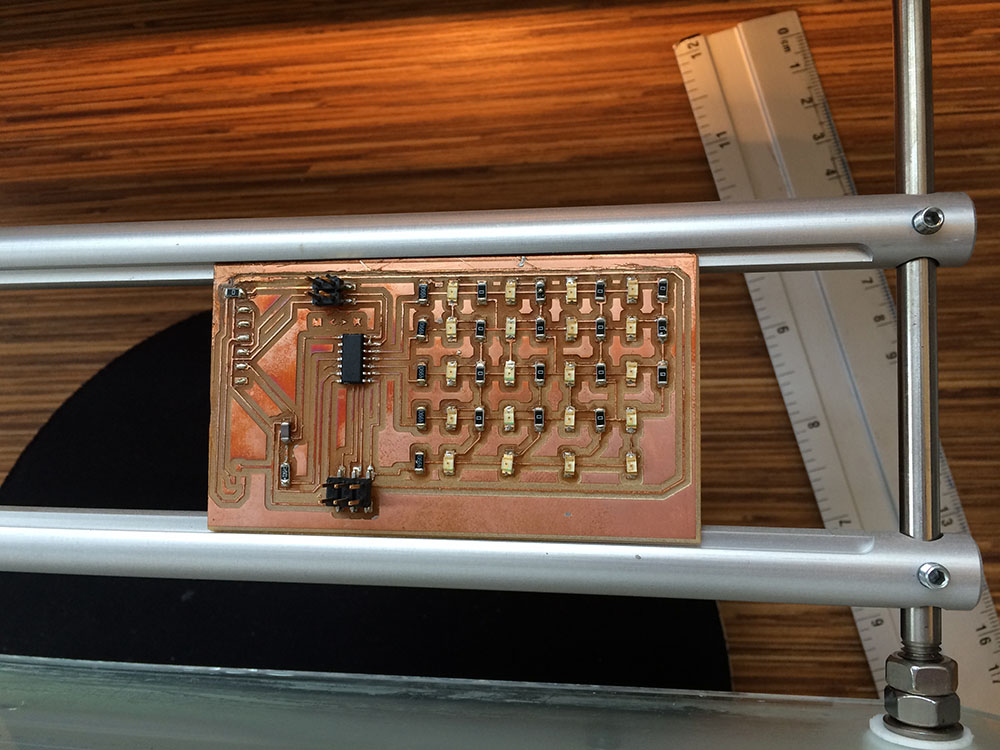 Related work: Who has done what beforehand?
Related work: Who has done what beforehand?
The concept was initiated in coversation with my colleague Gideon Bazen and then I explored further from there. Concept-wise I have not seen (m)any interactive physicalisations, let alone of sayings. But then, I always tell me students, if you have not found anything, then you have not searched long enough. So here is one artistic installation also based on a similar, from pillar to post idea.
Naturally, from a technical perspective, fellow Fab academy members have previously explored charlieplexing, ultra-sonic distance sensor and alike (such as for running), which I built on.
The upcoming field of data physicalisation is particularly noteworthy here. My recent trip to the Stedelijk museum in Amsterdam and CHI2016 have also been inspirational.
Random cool projects and themes using physical, tangible means:
- Playful physical interactions: Sewing machine game, Walt Disney research
- Destruction -seems to be a current trending theme> Now we can make almost everything, are we making too much?
- Alerting infrastructure, Jonah Brucker Cohen: Pneumatic drill that causes damage to the physical structure of the gallery when it’s website get a visitor
- Breaking Andy wall, Leo Kang
- Destructive laser games, Stefanie Mueller et al
- Physicalisation based on Twitter feeds (e.g. Twipology-Joelle Bitton)
- Magic: Wanderful alcove (My idea of using magic wands as interfaces continued by others)
Where do the components come from? What does it cost?
The components were all sourced locally (in The Netherlands). Luckily, there are a number of specialized shops in the neighbourhood (Radio rotor for electronics, etc) and most components were already there/ in the fab lab.
- For economic, quality and sustainability reasons, I mostly wanted to use material already in my posession, particularly:
- From the lab, I got (1) electronic components (such as LEDs, resistors and ATtiny44) for the Charlieplexing board (See BOM list in 'Files'), (2) a hc sr04 ultrasonic ditance sensor (±E2,-) and (3) LiPo battery (±E15,-)
- To experiment at later stage and be generally prepared, I got
- (1) Paverpol and Crackfree for hardening material
- (2) Sudoku like Protoplast material for shaping and molding
- (3) Electronics, particularly the Adafruit mp3 sound shield (E30,-) from Kiwitronics online as potential back up for the mp3 Touch board
- The most expensive material is the filament for the 3D U-printer which at my university is more expensive than the Ultimaker filament, but you also save waisting material due to its robustness (model material: 0.25 per cm2, Supportive material: 0.25 cm2 - Ultimaker 0.08 cm2). Discussed potential of recycling this plastic to save costs.
Project presentations: 15 June, 2016.
Future work: What might it be able to do?
The miniature version could be (re)produced and awarded by the public to parties that contribute (or fight?) against bureau crazyness, so as a physical means to empower the public and fight against this.
The installation could be connected and react to bureacrazy occurences on the internet. For example, it could search for certain bureacratic keywords on Twitter, or people could vote for the most bureacratic party online, which would then appear on the real wall of shame (through framed screen).
Other potential direction is to physicalize more sayings (e.g. with motorized elements and remote control), such as "If the mountain won't come to Muhammad then Muhammad must go to the mountain." This could also become part of an interactive educational textbook for playful language learning.
My design conditions (for evaluation):
- Make something that you can not buy in stores (no mass-production product)
- Make something that serves a non-commercial > public goal
- Make something personal (it has to be mine - not a copy)
- Make something physical (materialize and fight against the disappearing computer)
- Make something interesting / different/ new / invent!
- Make something interactive (as the outcome of digital fabrication is often not)
- Make something I can learn from
- Make something useful > worthwhile > meaningful > empowering
- Make something smart
- Make IT work
Most importantly....
- Make something... / anything!
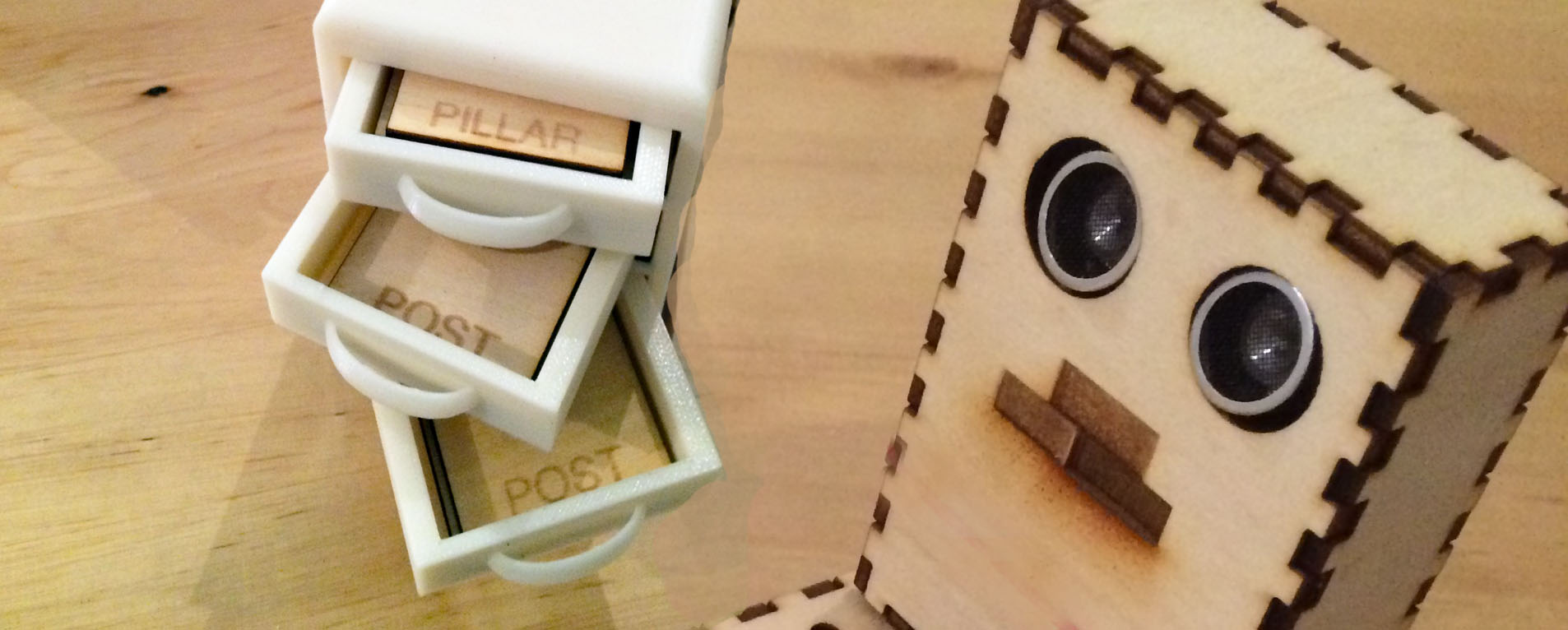 Final note
Final note
Thank you to all the lovely people who endured this intensive process with me!
Files
Make your own Bureau crazy award...
- Bill Of Materials for Charlieplex LED board (BOM .txt)
- Charlieplex LED board with Eagle (needs connecting line for last row, .brd | .sch)
- Cabinet -kastje (.stl for 3D printing )
- Casing distance sensor (.stl for 3D printing | .ai for laser cutting -do not forget engraving if desired)
- Casing board electronics (.ai includes different ways for enclosure)
- Bureau crazy award extra elements (.ai includes cabinet (pillar/post) inlays and base tray for laser cutting)
- Code for LED animating Charlieplex LED board (.ino - Arduino IDE)
- Code for distance sensing and sound output (.ino -Arduino IDE)
- Sound fragments ("ga naar het kastje"-go to the cabinet .mp3 | "ga naar de muur"-go to the wall .mp3)
Final presentation

